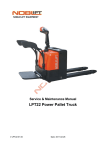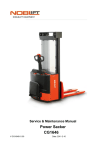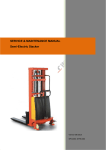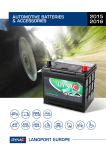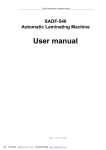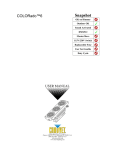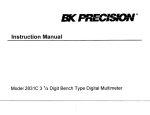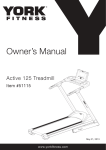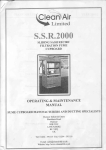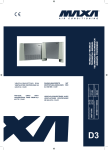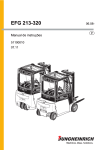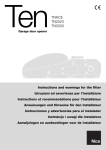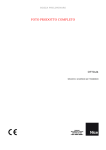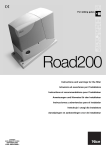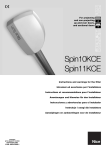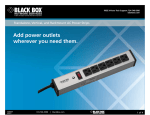Download Service & Maintenance Manual PS16W Electric Pallet Truck
Transcript
NOBLELIFT EQUIPMENT Service & Maintenance Manual PS16W Electric Pallet Truck V-PS16W-01.00 Date: 2013-11-28 CONTENTS 1. 2. 3. 4. 5. 6. 7. GENERAL.........................................................................................................................................3 1.1 INTRODUCTION – MAINTENANCE SAFETY PRECAUTIONS ................................................3 1.2 MEASUREMENT CONVERSIONS.............................................................................................7 SPECIFICATIONS ..........................................................................................................................11 2.1 LOCATION OF COMPONENTS ...............................................................................................11 2.2 SPECIFICATION SHEETS .......................................................................................................12 2.3 LUBRICATION..........................................................................................................................14 ELECTRICAL SYSTEM..................................................................................................................15 3.1 ELECTRICAL DIAGRAM .........................................................................................................15 3.2 DRIVE WHEEL .........................................................................................................................16 3.3 PUMP UNIT ..............................................................................................................................16 3.4 BATTERY .................................................................................................................................16 3.5 CHARGER ................................................................................................................................20 3.6 CURTIS CONTROLLER ...........................................................................................................25 3.7 BATTERY INDICATOR ............................................................................................................36 3.8 REPLACING THE ELECTRICAL PARTS ................................................................................38 3.9 TOOL FOR REPAIRING THE PIN OF ELECTRICAL PLUG ...................................................44 HYDRAULIC SYSTEM ...................................................................................................................45 4.1 HYDRAULIC FLOW DIAGRAM................................................................................................45 4.2 INSPECTION OF HYDRAULIC OIL .........................................................................................46 4.3 REPLACING OF THE CONTACTOR OF THE PUMP..............................................................46 4.4 REPLACING OF THE LOWERING MAGNETIC VALVE .........................................................47 4.5 REPLACING OF THE PUMP STATION ...................................................................................47 4.6 REPLACING OF THE CARBON BRUSH.................................................................................48 4.7 REPLACING OF THE STEERING ASSISTED PARTS AND SENSOR ...................................49 4.8 REPLACING THE STEERING MOTOR ...................................................................................50 4.9 REPLACIING OF THE CYLINDER...........................................................................................51 DRIVE WHEEL ...............................................................................................................................51 5.1 REPLACING OF THE DRIVE WHEEL (WITH POWER-ASSISTED STEERING) ....................51 5.2 REPLACING OF THE DRIVE WHEEL (WITHOUT POWER-ASSISTED STEERING) ............53 5.3 REPLACING OF THE BALANCE WHEEL...............................................................................54 5.4 REPLACE THE AC MOTOR SPEED SENSOR .......................................................................55 5.5 REPLACE OF THE BREAK .....................................................................................................55 5.6 REPLACING OF THE POSITION SENSOR OF HANDLE .......................................................56 5.7 STEERING CONTROLLER ......................................................................................................57 CONTROL HANDLE.......................................................................................................................58 6.1 REPLACING THE CONTROL HANDLE ..................................................................................59 6.2 REPLACING OF THE INTERLOCK SWITCH ..........................................................................61 6.3 REPLACING OF THE AIR SPRING .........................................................................................61 6.4 INSTALLATION OF THE AIR SPRING ....................................................................................62 TROUBLE DIAGNOSTICS .............................................................................................................63 7.1 REGULAR MAINTENANCE .....................................................................................................63 7.2 TROUBLE SHOOTING.............................................................................................................65 1 FOREWORD Proper operation, maintenance, troubleshooting and repairs are necessary to preserve the performance of the pallet truck over along period of time and ensure that fault and breakdowns do not occur. The object of this service manual is to provide the information necessary especially in connection with the performance of inspections and repairs mainly in the maintenance areas. The majority of this pallet truck consists of steel, it can be completely recycled. Waste material in conjunction with repairs, maintenance, cleaning or scrapping, must be collected and disposed of in an environment-friendly way and in accordance with the directives of respective countries. Such work must be carried out in areas intended for this purpose. Recyclable material should be taken care of by specialized authorities. Environmentally hazardous waste, such as oil filters, batteries and electronics, will have a negative effect on the environment, or health, if handled incorrectly. All of the information reported herein is based on data available at the moment of printing. Our products are constantly being developed and renewed, we reserves the right to modify our own products at any moment without prior notice and incurring in any sanction. So, it is suggested to always verify possible updates. 2 1. GENERAL 1.1 INTRODUCTION – MAINTENANCE SAFETY PRECAUTIONS Careless performing of the easy work may cause injuries. Take care to always perform work safely, at least observing the following. It is of utmost importance that maintenance personnel pay strict attention to these warnings and precautions to avoid possible injury to themselves or others, or damage to the equipment. A maintenance program must be followed to ensure that the machine is safe to operate. The specific precautions to be observed during maintenance are inserted at the appropriate point in the manual. These precautions are those that apply when servicing hydraulic and larger machine component parts. MODIFICATION OF THE MACHINE WITHOUT CERTIFICATION BY A RESPONSIBLE AUTHORITY THAT THE MACHINE IS AT LEAST AS SAFE AS ORIGINALLY MANUFACTURED, IS A SAFETY VIOLATION. SINCE THE MACHINE MANUFACTURER HAS NO DIRECT CONTROL OVER THE FIELD INSPECTION AND MAINTENANCE, SAFETY IN THIS AREA RESPONSIBILITY OF THE OWNER OR OPERATOR. FAILURE TO COMPLY WITH SAFETY PRECAUTIONS LlSTED IN THIS SECTION MAY RESULT IN MACHINE DAMAGE, PERSONNEL INJURY OR DEATH AND IS A SAFETY VIOLATION. When carrying out any operation or maintenance, have trained and experienced personnel carry out the work. When carrying out any operation or maintenance, carefully read out Operation and Maintenance Manual. Read all the precautions given on the decals which are fixed to the machine. Be sure you fully understand the contents of the operation. It is important to prepare necessary tools and parts and to keep the machine. Your safety, and that of others , is the first consideration when engaging in the maintenance of equipment. Always be conscious of weight. Never attempt to move heavy parts without the aid of a mechanical device. Do not allow heavy objects to rest in an unstable position. When raising a portion of the equipment, ensure that adequate support is provided. 3 It should be noted that the machines hydraulic systems operate at extremely high potentially dangerous pressures. Every effort should be made to relieve any system pressure prior to disconnecting or removing any portion of the system. Relieve system pressure by cycling the applicable control lowering button several times with the motor stopped and ignition on, to direct any line pressure back into the reservoir. Pressure feed lines to system components can then be disconnected with minimal fluid loss. Remove all rings, watches and jewelery when performing any maintenance. Wear well-fitting helmet, safety shoes and working Clothes When drilling grinding or hammering always. Wear protective goggles. Always do up safety clothes properly so that they do. Not catch on protruding parts of machines. Do not wear oily clothes. When checking, always release battery plug. DO NOT WEAR LONG HAIR UNRESTRAINED, OR LOOSE-FITTING CLOTHING AND NECKTIES WHICH ARE APT TO BECOME CAUGHT ON OR ENTANGLED IN EQUIPMENT. During maintenance do not allow any unauthorized person, to stand near the machine. Flames should never be used instead of lamps. Never use a buring flame to check leaks or the level of oil or electrolyte. Immediately remove any oil or grease on the floor of the operator’s compartment or on the handrail. It is very dangerous if someone slips while on the machine. Always use the recommended pure oil or grease, and be sure to use clean containers. Oil is a dangerous substance. Never handle oil, grease or oily clothes in places where there is any fire or flame. As preparation for use of fire extinguishers and other fire- fighting equipment. Keep the battery away from fire hazards. The generated gases are explosive. Store all the oils in a specified place. Keep the flammable things away from the machine. Do not smoke in the working site. Battery should always be disconnected during replacement of electrical components. Always use the grades of grease and oil recommended by NOBLELIFT choose the viscosity specified for the ambient temperature. 4 Exhaust gas is dangerous provide ventilation when working in a closed space. Avoid breathing dust that may be generated when handling components containing asbestos fibers. Wear a gas mask if necessary. When working on top of the machine, be careful not to lose your balance and fall. Hand a caution sign in the operator’s compartment (for example “Do not start” of “Maintenance in progress”). This will prevent anyone from starting or moving the machine by mistake. When welding on the machine or working on the electical system, ALWAYS turn the key switch OFF and remove the battery plug from the battery. Park the machine on firm, flat ground. Lower the fork to the min. height and stop the motor. Sulfuric acid in battery electrolyte is poisonous. Ist is strong enough to burn skin and eat holes in clothing. If you spill acid on your clothes or skin, immediately flush it with large quantities of water. When working on the battery, wear goggles or safety glasses. If splashed into the eyes, flush with water and get medical attention immediately. Battery terminals touched by metal objects can cause short circuit and burn you. Keep tools away from the terminals. When disassembling and assembling the battery, make sure that the battery terminals (+, –) are correctly connected. If water gets into the electrical system, abnormal operation or failure can result. Do not use water or steam on sensors, connectors and instruments in the cab. Do not handle electrical equipment while wearing wet gloves, or in wet places, as this can cause electric shock. When working with others, choose a group leader and work according to his instructions. Do not perform any maintenance beyond the agreed work. Unless you have special instructions to the contrary, maintenance should always be carried out with the motor stopped. If maintenance is carried out with the motor running, there must be two men present : one operating the pallet truck and the other one performing the maintenance. In such a case, never touch any moving part. Before making adjustment, lubricating or performing any other maintenance, shut off all power controls. 5 When removing parts containing O-ring Gaskets or seal. Make sure clean the mounting surface and replace with new sealing parts. Thoroughly clean the machine. In particular, be careful to clean the grease fittings and the area around the dipsticks. Be careful not to let any dirt or dust into the system. Use only approved, nonflammable cleaning solvents. When changing the oil or fitter, check the drained oil and filter for any signs of excessive metal particles or other foreign materials. Always use NOBLELIFT genuine parts for replacement. ENSURE REPLACEMENT PARTS OR COMPONENTS ARE IDENTICAL OR EQUIVALENT TO ORIGINAL PARTS OR COMPONENTS. When checking an open gear case, there is a risk of dripping things in. Before removing the covers to inspect such cases, empty everything from your pockets. Be particularly careful to remove wrenches and nuts. 6 1.2 MEASUREMENT CONVERSIONS Length Unit cm m km in ft yd mile cm 1 0.01 0.00001 0.3937 0.03281 0.01094 0.000006 m 100 1 0.001 39.37 3.2808 1.0936 0.00062 km 100000 1000 1 39370.7 3280.8 1093.6 0.62137 in 2.54 0.0254 0.000025 1 0.08333 0.02777 0.000015 ft 30.48 0.3048 0.000304 12 1 0.3333 0.000189 yd 91.44 0.9144 0.000914 36 3 1 0.000568 mile 160930 1609.3 1.6093 63360 5280 1760 1 1mm=0.1cm, 1m=0.001mm Area Unit cm2 m2 km2 a ft2 yd2 in2 cm2 1 0.0001 – 0.000001 0.001076 0.000012 0.155000 m2 10000 1 0.000001 0.01 10.764 1.1958 1550.000 km2 – 1000000 1 10000 1076400 1195800 – a 0.01 100 0.0001 1 1076.4 119.58 – ft2 – 0.092903 – 0.000929 1 0.1111 144.000 yd2 – 0.83613 – 0.008361 9 1 1296.00 in2 6.4516 0.000645 – – 0.006943 0.000771 1 1ha=100a, 1mile2=259ha=2.59km2 Volume Unit cm3 = cc m3 l in3 ft3 yd3 cm3 = m l 1 0.000001 0.001 0.061024 0.000035 0.000001 m3 1000000 1 1000 61024 35.315 1.30796 l 1000 0.001 1 61.024 0.035315 0.001308 in3 16.387 0.000016 0.01638 1 0.000578 0.000021 ft3 28316.8 0.028317 28.317 1728 1 0.03704 yd3 764529.8 0.76453 764.53 46656 27 1 1gal(US)=3785.41 cm3=231 in3=0.83267gal(US) Weight Unit g kg t oz lb g 1 0.001 0.000001 0.03527 0.0022 kg 1000 1 0.001 35.273 2.20459 t 1000000 1000 1 35273 2204.59 oz 28.3495 0.02835 0.000028 1 0.0625 lb 453.592 0.45359 0.000454 16 1 1 tonne(metric)=1.1023 ton(US)=0.9842 ton(UK) 7 Pressure Unit kgf/cm2 bar Pa=N/m2 kPa lbf/in2 lbf/ft2 kgf/cm2 1 0.98067 98066.5 98.0665 14.2233 2048.16 bar 1.01972 1 100000 100 14.5037 2088.6 Pa=N/m2 0.00001 0.00001 1 0.001 0.00015 0.02086 kPa 0.01020 0.01 1000 1 0.14504 20.886 lbf/in2 0.07032 0.0689 6894.76 6.89476 1 144 lbf/ft2 0.00047 0.00047 47.88028 0.04788 0.00694 1 kgf/cm2=735.56 Torr(mmHg)=0.96784atm Standard torque The following charts give the standard torque specification of bolts and nuts. Exceptions are given in the sections of “Disassembly and Assembly” METER TABLE Classification 4T, 5T 10T 10.9 Bolt type Bolt size Torque kgf · m (lbf · ft) Torque kgf · m (lbf · ft) M4 0.2 ± 0.02 0.4 ± 0.04 M5 0.3 ± 0.03 0.8 ± 0.08 M6 0.5 ± 0.05 1.4 ± 0.14 M8 1.2 ± 0.12 3.3 ± 0.3 M10 2.3 ± 0.23 6.5 ± 0.7 M12 4.0 ± 0.4 11.3 ± 1.1 M14 6.4 ± 0.6 17.9 ± 1.8 M16 9.5 ± 0.9 26.7 ± 2.7 M18 13.5 ± 1.4 38.0 ± 3.8 M20 18.6 ± 1.9 52.2 ± 5.2 M22 24.7 ± 2.5 69.4 ± 6.9 M24 32.1 ± 3.2 90.2 ± 9.0 M30 62.6 ± 6.3 176.1 ± 17.6 M36 108.2 ± 10.8 304.3 ± 30.4 M42 171.8 ± 17.2 483.2 ± 48.3 M45 211.3 ± 21.1 594.3 ± 50.4 8 INCH TABLE 4T, 5T 10T Bolt size Torque kgf · m (lbf · ft) Torque kgf · m (lbf · ft) 1/4 0.6 ± 0.06 1.7 ± 0.2 5/16 1.2 ± 0.12 3.0 ± 0.3 3/8 2.0 ± 0.20 5.6 ± 0.5 7/16 3.2 ± 0.32 8.9 ± 0.9 1/2 4.7 ± 0.47 13.4 ± 1.3 9/16 6.8 ± 0.68 19.0 ± 1.9 5/8 9.3 ± 0.93 26.1 ± 2.6 3/4 16.0 ± 1.60 45.1 ± 4.5 7/8 25.5 ± 2.55 71.6 ± 7.2 1 38.0 ± 3.80 106.9 ± 10.7 1-1/8 54.1 ± 5.41 152.2 ± 15.2 1-1/4 74.2 ± 7.42 208.9 ± 20.9 1-3/4 98.8 ± 9.88 277.8 ± 27.8 1-1/2 128.2 ± 12.82 360.7 ± 36.1 Classification Bolt type The torque specifications in above table shall not be applied to the bolts with nylon packings and nonferrous metal washers, or the ones with specifically designated torque and standard. H Newton meter : 1 N·m = 0.1kgf·m TIGHTENING TORQUE OF SPLIT FLANGE BOLTS The following torque shall be applied to the split flange bolts. Diameter Flat width (mm) (mm) kgf·m Torque N·m 10 14 6.7 ± 0.7 66.7 ± 6.8 12 17 11.5 ± 1 112 ± 9.8 16 22 28.5 ± 3 279 ± 29 9 APPROXIMATE CONVERSIONS SI Unit Conv Factor 0.113 1.36 7.22 × × × × × × × × × × × × × × 0.249 3.38 6.89 0.069 0.070 0.069 0.00689 = kPa = kPa = kPa = bar* = k f/ 2* = bar* = MPa × × × × Power r (W = J/s) 1.36 = PS (cv) 1.34 = HP 0.948 = Btu/s 0.74 = ft·lb/s × × × × 0.736 0.746 1.055 1.36 = = = = kW kW kW W × 1.055 × 4.19 = = kJ J kilopascal (kPa) kilopascal (kPa) kilopascal (kPa) (bar) (kg/cm2) newton/mm2 megapascal (MPa) (Pa=N·m2) Energy (J = N·m) × 0.948 = Btu × 0.239 = calorie kilojoule (kJ) joule (J) (J=N·m) SI Unit × × × × × × 8.9 0.74 0.102 Conv Factor = ln·in = lb·ft. = kg·m Pressure (Pa = N/m2) 4.0 = in. H2O 0.30 = in. Hg 0.145 = psi 14.5 = psi 14.22 = psi 145.04 = psi 145 = psi newton meter (N·m) newton meter (N·m) newton meter (N·m) kilowatt (kW) kilowatt (kW) kilowatt (kW) watt (W) (W=J/s) Non–SI Unit Torque = = = Velocity and Acceleration ×3.28 × 0.305 meter per sec (m/s ) = ft/s2 = × 3.28 × 0.305 meter per sec (m/s) = ft/s = × 1.61 kilometer per hour (km/h) × 0.62 = mph = Horse Power/Torque BHP × 5252 R.P.M. = TQ (lb·ft) TQ Z R.P.M. 5252 = B.H.P. Temperature °C = (°F–32) ÷ 1.8 °F= (°C Z 1.8) + 32 Flow Rate 3 × 0.264 liter/min (dm /min) = US gal/minZ3.785 = Note : ( ) Non–SI Unit 2 2 10 N·m N·m lb·ft.* m/s2 m/s km/h l/min 2. SPECIFICATIONS 2.1 LOCATION OF COMPONENTS 1. Key switch 13. Hydraulic cylinder 2. Discharge indicator and charging indicating LED 14. Battery cover 3. Emergency button 15. Battery 4. Foldable platform 16. Load wheels 5. Main cover 17. Safety (belly) button 6. Protective arm cover 18. Accelerator (butterfly button) 7. Protective arm 19. Tiller 8. Upper cover 20. Forks 9. Middle cover 21. Drive wheel 10. Protective screen 22. Castors 11. Chain 23. Load backrest 12. Mast CONTROL HANDLE 1. Raise/Lower buttons adjusting fork height. – Rocker switches 2. FWD/BWD/REV travel button –Control variable speed by turning knob 3. Emergency Reverse button – Emergency reverse button or commonly known as the belly button switch 4. Horn button 5. Indicator light – Indicates high/low speed status. Green indicates high speed, red indicates slow speed. 6. Shift button – Shift button for high speed and low speed 11 Additio nal data ElectricMotor Performa nce data Dimensions Tires, Chassis Weig ht Distinguishing mark 2.2 SPECIFICATION SHEETS Type sheet for industrial truck acc. to VDI 2198 1.2 1.3 1.4 1.5 1.6 1.8 1.9 2.1 2.2 2.3 3.1 3.2 3.3 3.4 3.5 3.6 3.7 4.2 4.3 4.4 4.5 4.9 4.15 4.19 4.20 4.21 4.22 4.25 4.32 4.33 4.34 4.35 5.1 5.2 5.3 5.8 5.10 6.1 6.2 6.3 6.4 6.5 6.6 8.1 8.4 Manufacturer`s type designation Power (battery ,diesel, petrol, gas, manual) Operator type Load Capacity / rated load Load centre distance Load distance ,centre of drive axle to fork Wheelbase Service weight Axle loading, laden front/rear Axle loading, unladen front/rear Tires Tire size, front Tire size, rear Additional wheels(dimensions) Wheels, number front/rear(x=driven wheels) Tread, front Tread, rear Lowered mast height Free Lift height Lift Extended mast height Height of tiller in drive position min./ max. Height, lowered Overall length Length to face of forks Overall width Fork dimensions Distance between fork- arms Ground clearance, centre of wheelbase Aisle width for pallets 1000X1200 crossways Aisle width for pallets 800X1200 lengthways Turning radius Travel speed, laden/ unladen Lift speed, laden/ unladen Lowering speed, laden/ unladen Max. gradeability, laden/ unladen Service brake Drive motor rating S2 60min Lift motor rating at S3 15% Battery acc. to DIN 43 531/35/36 A,B,C,no Battery voltage, nominal capacity K5 Battery weight Energy consumption acc. to VDI cycle Type of drive control sound level at driver`s ear acc. to EN 12053 12 PS 16W Q(t) c(mm) x(mm) Y(mm) kg kg kg x w (mm) x w (mm) x w (mm) b10mm b11 (mm) h1 (mm) h2 (mm) h3 (mm) h4 (mm) h14mm h13mm l1mm l2mm b1mm s/e/l (mm) b5 (mm) m2mm Ast (mm) Ast (mm) Wa (mm) km/h m/s m/s % kW kW V/Ah kg kWh/h dB(A) Battery Pedestrian 1.6 600 784 1336 1450 1400/1650 1130/320 Polyurethane (PU) 252 × 88 80 × 70 150× 54 1x+2 / 4 790 390/ 505 2105 4600 5112 961/ 1396 85 1895/1995 746/846 1050 60/180/1150 570/ 685 25 2403/2503 2314/2414 1540/1640 6.0 / 6.0 0.10/0.16 0.095/0.12 6 / 12 Electromagnetic 1.3 3.0 No, cells 4PzS 24/ 280 253 1.4 AC- speed control 70 13 2.3 LUBRICATION Hydraulic oil Hydraulic oil must have anti-wear qualities at least. It is not advisable to mix oils of different brands or types, as they may not contain the same required additives or be of comparable viscosities. Name: Thickened hydraulic oil. ISO Viscosity Grade Characteristics At 40OC Viscosity At 50OC Viscosity index Flash point, Cleveland open cup Pour point, Max Density at 15 OC Copper corrosion(100OC, 3h) Foaming (93.5 OC) Vickers vane pump test, loss of mass (on vanes after 100h) Diameter of wear spot, 1200 r/min, 294N, 30min, 75 OC The oil for gear box Name: Extreme pressure lithium-based grease, 1#. Characteristics Worked Penetration, 0.1mm Dropping point, Extreme pressure (Timken OK) Similar viscosity (-10 OC, 10s-1) Corrosion preventive properties (52 OC, 48h) Wire points oil (100 OC, 24h) 14 #40 #30 57 40 ≥150 ≥160 ≤-35 48 30 ≥150 ≥160 ≤-35 861.5 ≤1 ≤30/0 15.3 ≤0.5 unit mm2/s O C C kg/m3 degree ml / ml mg mm O ≤1 ≤30/0 ≤100 ≤0.5 unit O C N Pa.s Grade % 310--340 ≥170 ≥177 ≤250 1 ≤10 3. ELECTRICAL SYSTEM 3.1 ELECTRICAL DIAGRAM WIRING DIAGRAM FU1 : 10A FU2 : 0.5A FU3 : 15A FU 01: 150A FU 02: 200A 15 3.2 DRIVE WHEEL Type: 26EL-AC-1.3 KW Drive Motor Model HPQ1.3-4BT3 Rate voltage 16V AC R.P.M 3200rpm Rate output 1.3kw Rate hour 60min. Rated current 76.2A Amperager rating- max 110.7HZ Insulation class H transmission ratio i=1:30 Gear Box 3.3 PUMP UNIT Type: MR2-B-V1B-F4.5-PCMAV1Y-TK05C-F2 Item Specification Rated voltage 24V Rated output 3.0kw R.P.M 3300 rpm Rated current 200 A Rated hour 4.0 min. Insulation class IP Code F class Displacement 3.2cc/rec Max. operating pressure 200bar IP43 3.4 BATTERY Specification Rate PS16W Rated voltage 24V Capacity (5 hours) 280Ah Box size (L*W*H)(mm) 645X244X570 Cell size (L*W*H)(mm) 77x158x525 Initial charge When the battery is charged for the first time, you should prepare the exclusive sulfuric acid and excluslve water of lead acids (lf no excusive water is present in local areas, distilled water can be used). Slowly pour sulphuric acid into a container containing exclusive water(or distilled water), and churn it up with an acid-resistant stick. Keep it still until the fluid temperature drops to 35oC, then it can be poured into cells. The concentration of confected electrolyte is 1.280+0.005 (25 0C ). The conversion forrnula of electrolyte is: S25=St+0.0007*(t - 25) which: S25: The concentration of electrolyte in standard temperature of 25oC 16 St: The actually measured concentration of electrolyte. T: Actually measured temperature. When confecting electrolyte, avoid pouring water into concentrated sulphuric acid, for fear that sulphuric acid splashes and leads to physical injury. In addition, please wear protective appliance. Wipe up the cells, check the nuts be tight for reliable connection. Pour configured electrolyte into grouped batteries, with fluid level 15-20mm higher than protective slice. Keep it still for 4-6 hours (maximum duration no more than 12 hours). Only when the cells temperature drops below 350C can it be connercted to DC and charge. If cell’s temperature exceeds 35℃, it should be taken to cool it down. Check the cells in the battery for reverse polarity with DC voltmeter to assure proper polarity.Connect the anode of the power supply to “+ “of the battery, the cathode of the power supply to “-“ of the battery. Avoid reverse polarity for fear of reverse charging. The voltage of the charge power supply should be higher than 1.5 times of the charged battery. When all the work is properly done, the cells can be charged according to parameters outlined in the list below: Charging current (A) Model initial charge Phase 1 (0.5 I5A) Phase 2 (0.25 I5A) Phase 3 (0.7I5A) Phase 4 (0.35 I5A) 210Ah 21 10.5 29 14.5 280Ah 28 14 39 19 350Ah 35 17 49 24 Initial charges are conducted in 2 phases: in phase1, when terminal voltages of the cells rise to 2.4V, the current should be converted into phase2, and continue to charge until air bubbles come out from the electrolyte, keep cell voltage(under constant current) steady for 3 hours. When the concentration of confected electrolyte reaches 1.280 士 0.005, it should remain unchanged within 3 hours. At this moment, the total quantity of electric charge should be 4-5 times the rated capacity, and the charging duration will be 70 hours. If the concentration of the electrolyte is not 1.280 士 0.005, it should be adjusted. The method is: if the concentration is too high, draw out some electrolyte and add some water or distilled water, until the concentration equals to the prescribed value; if the concentration is too low, draw out some electrolyte and add some pre-confected dilute sulfuric acid with a concentration of 1.400g/cm3, until the concentration equals to the prescribed value. When the concentration of electrolyte is adjusted, it should be charged for 1 hour for consistency. The density-ratio of electrolyte is as follows: Concentration of electrolyte 1.100 1.200 1.270 1.280 1.400 common charge Volumeratio of water to sulfuric acid 9.80:1 4.33:1 2.80:1 2.75:1 1.90:1 Capacity ratio of water to sulfuric acid 5.84:1 2.36:1 1.57:1 1.49:1 1.00:1 After charging, close the vent plug , and it only can be put into use after its surface is cleaned clear. 17 Balanced charge When in use, nonuniformity of voltage capacity, electrolyte and concentration may occur. Through balanced charge, such nonuniformity can be eliminated, and all cells in the battery can be of uniform conditions. Balanced charge is essential monthly for the batteries in use or following situation: Cells whose discharge voltages are usually below the final voltage (1.7V/cell). Cells with heavy discharge current (in circumstances where the drive motor and lift motor operate synchronously with heavy load), or in circumstance with steep slope. Cells not timely recharged after discharged. Undercharged cells of cells not used for a long time. METHODS OF BALANCED CHARGE: Normally charge the cells, when it is fully charged, shut off the charge power supply, keep it still for half an hour, then switch on the power supply and continue to charge with the current of phase 2. When air bubbles come out, convert to 1/2 of the current of phase 2 and continue to charge the cells, when air bubbles are produced, shut off the charge power supply, keep is still for half an hour, then switch on the power supply and continue to charge with 1/2 of the current of phase 2, until air bubbles are produced, stop charging and left it still. Repeat the procedure for several times, until air bubbles are produced as soon as power supply is connected. In balanced charge, voltage of each cell as well as the electrolyte concentration should be measured and recorded. Before the charge is completed, the electrolyte concentration and height should be adjusted to the prescribed parameters. SULFURIC ACID FOR CELLS Index name Index Sulphuric acid (H2S04) % ≥92 Ignition residue % ≤0.03 Manganese (Mn) % ≤0.0005 Ferrum(Fe) % ≤0.005 Arsenic(As) % ≤0.00005 Chlorine(Cl) % ≤0.0005 Nitrogenoxides(calculatedby N) % ≤0.0001 Ammonia salt (NH4) % ≤0.001 Sulfur dioxide(S02) % ≤0.004 Copper (Cu) % ≤0.0005 Deoxidized potassium permanganate (0) % ≤0.001 Chorma ml ≤1.0 mm ≥160 Transparency WATER FOR LEAD ACID CELLS Index Index name % Appearance Mg / l Achromatic, transparent Residue content ≤ 0.01 100 Manganese (Mn) content ≤ 0.00001 0.1 Ferrum(Fe) content ≤ 0.0004 4 Chlorine(Cl) content ≤ 0.0005 5 Ammonia salt content ≤ 0.0003 3 18 Ammonia (NH4) content ≤ 0.0008 8 Deoxidized potassium permanganate (0) content ≤ 0.0002 2 Solonetz meatal oxide(CaO) content ≤ 0.005 0 Resustivity(25 C) Ω.cm 50 4 10x10 ≥ ELECTROLYTRE FOR LEAD ACID CELLS Index Index name % Appearance Mg / l Achromatic, transparent Sulphuric acid (H2S04) content 0 15~40 3 Concentration 50 C, g/cm 180~480 1.1~1.3 Ignition residue content ≤ 0.02 0.24 Manganese (Mn) content ≤ 0.00004 0.00048 Ferrum(Fe) content ≤ 0.004 0.048 Arsenic(As) content ≤ 0.00003 0.00036 Chlorine(Cl) content ≤ 0.0007 0.0084 Ammonia salt content (N) ≤ 0.0005 0.006 Copper (Cu) content ≤ 0.002 0.024 Deoxidized potassium permanganate content ≤ 0.0008 0.01 Content calculated by KMn04 ≤ 0.0032 0.038 Don't spatter electrolyte or water into the batteries otherwise the battery tank will be eroded and the battery will automatically discharge, which will lead to low performance of battery and even shorter life. If electrolyte or water are spattered into the unintentionally, please discharge with the exclusively equipped plastic pipes. DISCHARGE CURVE voltage (V) 5hr discharge curve 2.1 2.05 2 1.95 1.9 1.85 1.8 1.75 1.7 1.65 1.6 0 1 2 3 time(h) 19 4 5 6 voltage ( V) 0.5hr disvharge curve 2 1.95 1.9 1.85 1.8 1.75 1.7 1.65 1.6 1.55 1.5 1.45 1.4 0 5 10 15 20 time(min) 3.5 CHARGER Type: DF2440 for 24V/280Ah WIRING DIAGRAM FOR CHARGER 20 25 30 35 The battery generates flammable and explosive gases during charge, so excellent ventilation is required. Open the liquid refilling cap or seal cap. Do not smoke around the battery during charge. Any fire and spark is forbidden. MAIN PRODUCT SPECIFICATION Type Input power Battery capacity Input voltage Output voltage Output current range DF2440 1.9KVA 270-300 220v 31.2 40A ENVIRONMENTAL CONDITION No. Item Technical specification 1 Humidity 5%-80% 2 Altitude ≦2000 3 Cooling Fan convection cooling Unit Remark With package m Work normally Working under full load ELECTRICAL CHARACTERISTICS 1 Input characteristics No. Item Technical specification Unit 1.1 Rated input voltage 220 Vac 1.2 Input voltage range 209-231 Vac 50—60 Hz 1.3 AC input voltage frequency 1.4 Max input current 1.5 Fan function 2 Output characteristics No. Item Technical requirements Unit 2.1 Fast charge voltage 28.8 Vdc 2.2 Floating voltage 31.2 Vdc 2.3 Maintain voltage 28.8 Vdc 2.4 Constant current 2.5 Power efficiency 3 Protection characteristics No. Item 3.1 Output DF2440:8 220Vac A When input is on,voltage for fan,When input voltage is off,there is no output voltage for fan over voltage protection DF2440:40 Thermal protection Remark A ≥80% Technical requirements Unit 32 V When the transformer temperature is higher than 3.2 Remark 125 ℃ -130 ℃ , the charger automatically protect, stop charging. 21 Remark 3.3 3.4 3.5 Output current DF2440:40 limiting protection A Output short circuit If a short circuit load, the charger will be protected and protection will not work. Electronic reverse The battery protection permanent revers battery connection charger is electronically 4 Charger(LED) indicator No. Item Status LED 1 Power on Power LED on (Yellow) 2 Power off Power LED OFF 3 Fast Charge Full LED ON (RED) 4 Floating Charge Full LED ON (RED) 5 Full LED ON (GREEN) 6 Fault LED Charging Battery protected against Remark LED (RED) DF2440 charger Equalizing charge Power switch BEFORE CHARGING The charger shall be installed in a special, ventilated, dry, no dust, no corrosive gas, no interference from high electromagnetic field place. The shell of the charger should be earthed (the ground bolts are equipped at the lower part of the case). The charger is only available for indoors, off-board charger. No water should be in the charger. The input power supply is 1- phases, 220V±5%~230V±5%, 50Hz or 110V±5%, 50Hz.The lead section shall be no less than 4 mm², while the capacity of mains switch shall be no less than 30A.You are recommended to use the dynamic mains switch. Appropriate cables may be employed according to the distance between power supply and the charger, which makes the voltage drop no more than 5%. Applicable environmental temperature for the charger is from -10℃ to 40℃ and the height less than 1000 meters. During use, the stumbling block that affects heat radiation of the charger shall be 0.6 meter away from it. Please check the blower is running normally or not regularly. In case of failure of microcomputer controller, please inform the service engineer or maintenance 22 staff. Check height of electrolyte in the battery in accordance with the manufacturer’s instructions. COMMON CHARGE Connect cable plug of the battery to corresponding output plug of the charger firmly. Connect the battery firstly, then connect it to the power supply and finally start it. If the output plug is connected to the electric control terminal of the vehicle mistakenly, the charger fails to work, the indicator light for “failure” is on, please correct it timely. Connect the charger to power supply first, then turn on the power air switch and the charger starts after the power is connected. The indicator light for power supply is on and the charger is under self-examination condition. The display indicates current system version, chargeable battery voltage, current battery voltage, maximum chargeable current and other data. After the self-examination process is completed, the charger begins charging. The display indicates voltage[**.*V], charge current [**.*A], charge time[H**.**] (shows ** Hour, ** Minute) and charged electric quantity [***AH]. When the display indicates “Charge completion” and the indicator light is on, the battery finishes charge. The charger enters floating charge, with current of 1-3 amperes. Please check electrolyte height in the battery frequently and fill distilled water timely as required. Disconnect the power switch, and disconnect the output cable plug of the charger and plug of battery and the charge is completed. EQUALIZING CHARGE When the battery group has been used for some time, the performance parameters of the batteries may vary differently, so equilibrium (constant current) charge is required. If equalizing charge is required, press the key for “Balance” charge, turn on the power switch, then the indicator light for “Balance” is on. The charger enters into equalizing charge status, the current value reduces from the rated value to a constant current value during charge, meanwhile, the display indicates “-FC-“. When the equalizing charge is completed, manual turning off is required (note: the output current of the charger under equalizing charge is constant without stop, manual turning off is necessary). Press the key for “Balance” charge after turning off the charger to make it return to normal charge. The equalizing charge is a manual operation. Appointed personnel are required to observe and check voltage and specific gravity of the batteries and determine charge time, manual power off and charge stop as required. TROUBLESHOOTING Failures Causes Troubleshooting The indicator light for power is on, the indicator light for failure is on, the blower is on, the charger can not start and charge and the monitor is not display . The battery is not connected, or the output plug of the charger is inserted into the controller plug of the electric vehicle. Connection of the battery should be corrected. The indicator light for power is on, the indicator light for failure is on, the blower is on, the ① Although the charger and battery is connected, however, some part of which is ① Check each connection bolt and wiring. 23 charger can not start and charge and the monitor is not display . disconnected. ②The battery is aging, becomes invalid and low voltage. ③The battery oppositely. The indicator light for power is on, the indicator light for failure is on, the blower is on, the charger can not start and charge and the display. Instable charge current, more or less. Instable charge current, not reaching the rated current value. Air switch of the charger does not trip, and the preceding stage switch trips. Failure of is connected DC output fuser. Open the side door to check the fuser. If the fuser is broken, please change a new one. Long-term heating, poor contact or loose by the output plugs. Check the copper plates, if it is unavailable, please change a new one. ① Low power voltage. ① The power voltage may not lower than 95% of the rated voltage. If the voltage is too low, please change a new power supply. ② The section area of input lead of power supply may not less than the stipulated section area in the manual. ② Small section area of lead for power input. ① Failure of the preceding air switch. ② Incorrect matching of air switch. ③ Small capacity of the air switch. Rated current of the preceding stage air switch is more than that of the air switch of the charger. The air switch must be type D (dynamic type),type C (illumination type) is unavailable. Internal short circuit of single battery of the group. Check each terminal voltage of every single battery. If some of the voltages are lower than their nominal voltages, the internal polar plates suffers from short circuit, please remove them and change new ones. Failure of microcomputer control power. Please inform engineers. Excessive overcharge for the battery. The display signals of the display face rolling, deadlock and clobber. ② Check total voltage of battery and each single voltage of the battery. In case of open circuit, aging, invalid, low voltage of the battery, please change a new one. ③ Correct the incorrect connection. 24 or the service 3.6 CURTIS CONTROLLER CURTIS 1311 HANDHELD PROGRAMMER The Curtis 1311 handheld programmer provides programming, diagnostic, and test capabilities for the controller. The power for operating the programmer is supplied by the host controller via a 4-pin Molex connector. The programmer includes a 7-line alphanumeric LCD display, rockertype keys for navigating through the display and for modifying parameters (+/-), and three keys that can be used as bookmarks. The 1311 programmer is easy to use, with self-explanatory functions. After plugging in the programmer, wait a few seconds for it to boot up and gather information from the controller. For experimenting with settings, the programmer can be left plugged in while the vehicle is driven. 25 The bookmark keys allow you to quickly go back to up to three selected items without having to navigate back through the menu structure. To set a bookmark, press one of the bookmark keys for about three seconds, until the Bookmark Set screen is displayed. To jump to a set bookmark location, quickly press the appropriate bookmark key (1, 2, or 3). Note that the bookmarks are not permanently stored in the programmer. They are cleared when the programmer is unplugged. The bookmark keys can be used to make parameter adjustment easier. For example, in adjusting the throttle deadband, you might set a bookmark at the Throttle % readout [Monitor > THROTTLE %] and another at the Throttle Deadband parameter [Program > THROTTLE DB]; this way you can easily toggle between the readout and the parameter. Connect the 1311 handheld programmer to the truck and switch on the power, Program parameter shown as below: Menu 2 Menu 3 Menu 4 Menu 5 Value Min Max Unit Mast Momentary Switch Enable On Off On PD Enable Off Off On 1 0 32767 Max Speed 4200 0 5000 rpm Drive Current 100 5 100 % Accel Rate 1.8 0.1 30 Seconds Decel Rate 1.5 0.1 30 Seconds Max 2100 0 5000 rpm Turning Switch Max Speed 2100 0 5000 rpm Arm close Standon Max Speed 4200 0 5000 rpm Arm close Wakier Max Speed 4200 0 5000 rpm Arm open Wakier Max Speed 4200 0 5000 rpm Arm open Standon Max Speed 4200 0 5000 rpm Turtle Max Speed 2100 0 5000 rpm Mode Settings control Motor define type High Mode Speed Speed limitation set Mast High Speed Interlock brake 26 decel rate Mast high Mode 3 0.1 30 Seconds Mast low Mode 1 0.1 30 Seconds Max Speed 4201 0 6000 rpm 0 0 180 Steer Angle Deadband (Deg)-Left 70 0 180 Steer Deadband (Deg)-Right Angle 110 0 180 Max 180 0 180 30 0 100 % Lower PD Max Current 0.7 0.0 1 2 Ampere Lower PD Current Min 0.35 0.0 1 2 Ampere Step1 Lower follow lift PD Max Current 0.35 0.0 1 2 Ampere Step1 Lower follow lift PD Min Current 0.35 0.0 1 2 Ampere Step2 Lower follow lift PD Max Current 0.35 0.0 1 2 Ampere Step2 Lower follow lift PD Min Current 0.35 0.0 1 2 Ampere Lift PD Current Max 0.68 0.0 1 2 Ampere Lift PD Current Min 0.02 0.0 1 2 Ampere Lift Pot Min 50 0 4095 Lift Pot Max 4050 0 4095 Lower Pot Min 50 0 4095 Lower Pot Max 4050 0 4095 Steer Angle Speed Reduction Steer Angle (Deg)-Left Max Steer Angle (Deg)-Right Full Turn Speed Hydro Setting Current set Pot input Delay set 27 Pump Delay to Lift 0.1 0.1 30 Seconds Delay PD closed after Pump lift 1.5 0.1 30 Seconds Delay after lift 0.8 0.1 30 Seconds 0 0 2 Max Speed 3048 100 8000 rpm Kp 20 0 100 % Ki 20 5 100 % Accel Rate 1.8 0.1 30 Seconds Decel Rate 1.5 0.1 30 Seconds Brake Rate 1 0.1 30 Seconds Pump Enable Off Off On Max Speed 3048 100 8000 rpm Kp 20 0 100 % Ki LS 20 5 100 % Ki HS 30 5 100 % Kvff 0 0 500 Ampere Build Rate 1 0.1 5 Seconds Release Rate 0.4 0.1 5 Seconds Kaff 0 0 500 Ampere Kbff 0 0 500 Ampere Build Rate 1 0.1 5 Seconds Release Rate 0.4 0.1 5 Seconds Full Accel Rate HS 3.6 0.1 30 Seconds Full Accel Rate LS 1.8 0.1 30 Seconds Low Accel Rate 10 0.1 30 Seconds Neutral Decel Rate HS 1.5 0.1 30 Seconds Neutral Decel Rate LS 3 0.1 30 Seconds Full Brake Rate HS 1 0.1 30 Seconds Full Brake Rate LS 2 0.1 30 Seconds Lower Control Mode Select 0 - Speed Mode Express 1 - Speed Mode Speed Controller Vel Feedforward Acc Feedforward Response 28 Low Brake Rate 1.5 0.1 30 Seconds 6 0.1 30 Seconds HS (High Speed) 70 0 100 % LS (Low Speed) 30 0 100 % Reversal Soften 20 0 100 % Max Speed Accel 1 0.1 30 Seconds Max Decel 0.5 0.1 30 Seconds Off Off On Max Speed 4000 500 8000 rpm Kp 30 0 100 % Ki 30 5 100 % Kd 10 0 100 % Accel Rate 1 0.1 30 Seconds Accel Release Rate 0.4 0.1 2 Seconds Brake Rate 1 0.1 5 Seconds Brake Release Rate 0.4 0.1 2 Seconds Neutral Braking 10 0 100 % Neutral Taper Speed 500 200 6000 rpm Creep Torque 0 0 100 % Brake Full Creep Cancel 50 25 100 % Creep Build Rate 0.1 0.1 5 Seconds Creep Rate 3 0.1 5 Seconds Gear Soften 20 0 100 % Brake Speed 1000 200 6000 rpm Reversal Soften 20 0 100 % Max Decel 10 0.1 30 Seconds Restraint Forward 50 0 100 % Restraint Back 50 0 100 % Soft Stop Speed 0 0 500 rpm Off Off On Fine Tuning Partial Rate Decel Speed Pump Enable 2 - Torque Mode Speed Limiter Response Fine Tuning Release Taper Speed Restraint Position Hold Position Hold Enable 29 Kp 10 2 100 % Kd 15 0 100 % Set Speed Settling Time 3013 0 5000 ms Set Speed Threshold 30 5 100 rpm Entry Rate 50 5 100 % 50 0 100 % Exit Reduction Rollback Current Limits Drive Limit Current 100 5 100 % Regen Limit Current 100 5 100 % Brake Limit Current 100 5 100 % EMR Limit Current 100 5 100 % Interlock Brake Current Limit 100 5 100 % PL Nominal Speed 500 100 4000 rpm Delta Speed 500 50 1000 rpm Nominal 90 0 100 % Plus Delta 80 0 100 % Plus 2xDelta 75 0 100 % Plus 4xDelta 65 0 100 % Plus 8xDelta 35 0 100 % Nominal 100 0 100 % Plus Delta 100 0 100 % Plus 2xDelta 100 0 100 % Plus 4xDelta 100 0 100 % Plus 8xDelta 100 0 100 % Throttle Type 5 1 5 Forward Deadband 0.5 0 5 Volt Forward Map 35 0 100 % Forward Max 4.5 0 5 Volt Forward Offset 0 0 100 % Reverse Deadband 0.5 0 5 Volt Power Map Limiting Drive Limiting Map Regen Limiting Map Throttle 30 Reverse Map 35 0 100 % Reverse Max 4.5 0 5 Volt Reverse Offset 0 0 100 % Throttle Filter 10 2 125 Hz HPD SRO Type 1 0 3 Sequencing Delay 0.1 0 5 VCL Enable Throttle Off Off On Brake Enable Pedal Off Off On Brake Type 5 1 5 Brake Deadband 0.5 0 5 Volt Brake Map 50 0 100 % Brake Max 4.5 0 5 Volt Brake Offset 0 0 100 % Brake Filter 10 2 125 Hz VCL Enable Off Off On Brake Type 2 0 2 Pull In Voltage 100 0 100 % Holding Voltage 80 0 100 % Battery Voltage Compensated On Off On Set EM On Fault Brake On Off On Set Speed Threshold 30 5 100 rpm Release Delay 60 40 2000 ms Set Speed Settling Time 3013 0 5000 ms Torque Delay Preload 200 0 800 ms Torque Enable Preload On Off On Torque Preload Cancel Delay 0 0 120 EM Brake Fault Motor Revs 4 1 20 On Off On Seconds Brake Brake EM Brake Control Drivers Main Contactor Main Enable 31 Seconds Pull In Voltage 100 0 100 % Holding Voltage 80 0 100 % Battery Voltage Compensated On Off On Interlock Type 0 0 2 Open Delay 0.1 0 40 Weld Check Enable On Off On Main DNC Enable On Off On Main DNC Runtime Threshold 5 0 200 Precharge Enable On Off On PD Enable Off Off On Hyd Lower Enable Off Off On PD Max Current 0 0 2 Ampere PD Min Current 0 0 2 Ampere PD Dither % 0 0 100 % PD Dither Period 16 16 112 ms PD Kp 10 1 100 % PD Ki 10 1 100 % Contactor Enable Off Off On Pull In Voltage 100 0 100 % Holding Voltage 80 0 100 % Driver 1 Enable Checks On Off On Driver 2 Enable Checks Off Off On Driver 3 Enable Checks Off Off On Driver 4 Enable Checks Off Off On PD Checks Enable Off Off On External Supply Max 200 0 200 mAmper e External Supply Min 0 0 200 mAmper e PWM Frequency 200 100 1000 Hz Typical Speed 4000 500 8000 rpm Off Off On Check Seconds Volt Proportional Driver Driver 3 Fault Checking Motor Swap Max Encoder 32 Direction Swap Phases Two Off Off On 64 32 256 Encoder Solution 0 0 2 Fault Enable Detection On Off On Encoder Pulse Fault Detect Time 0.5 0 3 Seconds Fault Stall Time 5 0 10 Seconds LOS Upon Encoder Fault On Off On LOS Max Speed 800 100 2000 rpm LOS Max Current 400 100 650 Ampere LOS Max Mod Depth 50 15 100 % LOS Accel Rate 7 2 15 Seconds LOS Decel Rate 3 2 15 Seconds Sensor Enable On Off On Sensor Type 3 1 5 Sensor Offset 0 -20 20 deg C Temperature Hot 145 0 250 deg C Temperature Max 160 0 250 deg C MotorTemp Max Speed 800 100 3000 rpm Nominal Voltage 24 24 84 Volt Undervoltage Cutback Range 7 2 14 Volt User Overvoltage 125 115 200 % User Undervoltage 70 50 80 % Reset Volts Per Cell 2.09 0.9 3 Volt Full Cell Per 2.04 0.9 3 Volt Empty Volts Per Cell 1.73 0.9 3 Volt Discharge Time 34 0 600 Minutes BDI 75 0 100 % Encoder Steps Encoder Options Encoder Setup Fault Temperature Control LOS Battery Volts Reset 33 Percent Dual Drive Dual Enable Motor Off Off On Dual Motor Slave Off Off On CAN Node Other 2 0 127 800 100 8000 90 45 90 Turn Accel Rate 5 0.1 30 Critical Angle (deg) 70 45 90 Max Turn Speed 30 0 100 % Inner Wheel Speed -100 -10 0 0 % Steer Type 5 1 5 Steer Pot Min 0.5 0 5 Volt Steer Pot Zero 2.5 0 5 Volt Steer Pot Max 4.5 0 5 Volt VCL Steer Enable Off Off On Turn Accel Rate 5 0.1 30 Critical Angle (deg) 70 45 90 Steer Fault Min 0.25 0 5.5 Volt Steer Fault Max 4.75 0 5.5 Volt Turn Accel Rate 5 0.1 30 Seconds Turn Kvff 0 0 500 Ampere Turn ff Build Rate 1 0.1 5 Seconds Turn ff Release Rate 0.4 0.1 2 Seconds Metric Units Off Off On Speed to RPM 691.3 10 3000 Capture Speed 1 4500 0 8000 rpm Capture Speed 2 4500 0 8000 rpm Capture Distance 1 22 1 1320 Capture Distance 2 100 1 1320 Capture Distance 3 150 1 1320 ID LOS Max Speed rpm Master Steer (deg) Angle Max Seconds Slave Seconds Turn Feedforward Vehicle Emergenc y Reverse 34 EMR Enable On Off On EMR Type 1 0 3 On Off On EMR Time Limit 5 0 30 Seconds EMR Speed 1000 50 6000 rpm EMR Accel Rate 1 0.1 3 Seconds EMR Decel Rate 1 0.1 3 Seconds Enable On Off On Decel Rate HS 0.5 0.1 30 Seconds Decel Rate LS 0.5 0.1 30 Seconds Interlock Timeout 5 0 8 Seconds CANopen Interlock Off Off On CAN Node ID 1 38 0 127 CAN Node ID 2 39 0 127 CAN Node ID 3 40 0 127 CAN Node ID 4 41 0 127 Supervisor Node ID 70 0 127 Baud Rate 0 -3 2 Heartbeat Rate 100 16 200 ms PDO Period 100 0 200 ms Emergency Message Rate 16 16 200 ms Suppress CANopen Init 0 0 1 Test Enable 0 0 1 Test Throttle 0 -1 1 Motor Poles 4 2 8 Max Test Speed 1000 500 3000 rpm Max Test Current 80 20 100 % SlipGain 3.85 0 200 EMR Interlock Dir Interlock Braking Brake CAN Interface Timeout Motor Control Tuning Motor Characterization Tests 35 Field Weakening Control FW Base Speed 1550 200 6000 rpm Field Weakening 30 0 100 % Weakening Rate 40 0 100 % Min Field Current 0 0 800 Ampere 0 0 205 0 0 1 Motor Type Reset Controller 3.7 BATTERY INDICATOR Type: CURTIS 803RB2448BCJ3010 Front View Rear View TERMINAL ASSIGNMENT Pin 7 or 8 = Battery +. Single voltage models: Pin 8 to battery +; Pin 7, open. Dual voltage models: When vehicle voltage is the higher voltage of the 2 operating voltages, Pin 8 connects to battery +; Pin 7, open. When vehicle voltage is the lower of the 2 operating voltages, Pin 7 connects to battery +, Pin 8, open. The discharge indicator uses Pin 7 or 8 for its battery state-of-charge measurements. Connection are to be made as close as possible to battery to prevent voltage drops that will cause errors in discharge indicator readings. The connection is not to be switched by the vehicle’s keyswitch. Pin 5 = Battery – Connect to battery ground as close to battery as possible. Pin 2 = Keyswitch. The keyswitch turns on and off the LED display of the battery discharge indicator. Monitoring of the battery continues when Pin 2 is turned off and the display is not lit. The hour meter display is unaffected by Pin 2, although it cannot accumulate more time as long as the keyswitch pin is not energized. The control inputs HRM (+) and HRM (–) are enabled by the keyswitch. Pin 2 is connected to the vehicle’s keyswitch. Pins 1 & 6 = Hour Meter Control. In normal operation, Pin 1 or 6 is connected and the other is left open. Only one of these pins is connected when using normal hour meter function. It is possible to or the hour meter between the two inputs so that it accumulates the total time either system is on. Hour meter 36 control logic is detailed in Table 2. Pin 6 = Hour Meter +. HRM (+) (for use with a switched positive voltage). Pin 6 connects to a high voltage as defined in Table 1. to activate the hour meter. Leaving Pin 6 open or connecting it to a low voltage gives control of the hour meter to the Hour Meter (–) input. See Table 2. Pin 1 = Hour Meter –. HRM (–) (for use with a switched ground). Pin 1 connects to a low voltage level as defined in Table 1 to activate the hour meter. Leaving Pin 1 openor connecting it to high voltage gives control of the hour meter to the Hour Meter (+) input. Pin 3 = Relay. Pin 3 connects in series with the lift coil circuit (or the circuit to be switched at empty). For holding relay (J), Pin 3 must be electrically closer to battery + than Pin 4 Pin 4 = Relay. Pin 4 also connects in series with the circuit to be switched at empty. HOUR METER CONTROL LINES & IMPEDANCE SPECIFICATIONS Low Voltage (max.) Hight Voltage (min.) 5.0VDC 15.0VDC Min. Impedance HRM+ HRM- 80kΩ 20 kΩ HOUR METER CONTROL LOGIC Pin 1 (HRM-) Pin 6 (HRM+) Hour Meter Status High Low Off High Open Off Open Low Off Open Open Off Low High On Low Low On Low Open On High High On Open High On DISCHARGE ADJUSTMENTS The followed table lists the voltages per cell under load that correspond to an empty indication on the gauge (lockout point). Setting K L M N O P Q R S T U Volt/Cell at Empty 1.57 1.63 1.68 1.73* 1.78 1.82 1.84 1.86 1.89 1.91 1.93 NOTE: “*” – factory setting RESET TYPE/LEVEL (AFTER OR DURING RECHARGE) CTR = Charge Tracking Reset: If the gage is connected to the battery during recharge, the gage will track the battery charge level. OCR = Open Circuit Reset: If the gage is disconnected from the battery during recharge, the gage will retain the last indication. It will advance to full when reconnected only if the battery voltage is above the OCR level. For standard (“B”) reset, OCR = 2.09 VPC (VPC = volts per cell.) 37 TROUBLESHOOTING Problem Possible Causes No display Terminals not connected or improper voltage Stays at FULL Instrument voltage does not match battery voltage, B+ connected to the wrong terminal Will not reset Instrument voltage does not match battery voltage, or battery not fully charged Resets w/o charging battery Not connected directly to battery terminals EMPTY too soon B+ connected to wrong terminal, or instrument voltage does not match battery voltage, or terminals not directly connected to battery 3.8 REPLACING THE ELECTRICAL PARTS Lower the forks to the bottom and switch off electrical power before operation! STEP 1: remove 4 screws from the control panel with 6mm Allen wrench. STEP 2: remove the cover of the Electrical box with 6mm Allen wrench. REPLACING OF THE BATTERY IINICOTOR 38 STEP 1: Unplug the connectors of the indicator, remove the screws, then you can remove it. STEP 2: Remove 4 screws of the panel with 5mm Allen wrench. Instruction : ① Blank ②、③ positive pole input through the key switch ④ positive pole output ⑤ negative pole input ⑥ Positive pole input through the micro switch of control handle ⑦ positive pole input ⑧ Blank B. REPLACING OF THE KEY SWITCH AND EMERGENCY SWITCH 39 STEP 2: Unplug the connectors (1‐ , 1‐1‐) of the emergency button with hand. STEP 1: Remove 2 cables signed B+, FU+ of the emergency button with 14mm spanner. The connectors are tight, so you should press the snap first and unplug it hard. STEP 3: Unplug the connectors (1-1-, 5-) of the key switch with hand. STEP 4: Remove the panel. STEP 5: Remove 4 screws of the panel with 2.5mm wrench. STEP 6: Rotation the screws anticlockwise and then you can remove the key switch. STEP 7: Remove 2 screws fixing the emergency button with cross wrench. STEP 8: Remove the top cover of the emergency button. 40 STEP 9: Remove 2 screws fixing the emergency button with 3mm Allen wrench. STEP 5: remove the black connector, and then you can replace the emergency button. description cause management no display One pin or the entire pin without voltage find out the cause display no hour display If ④pin wit voltage One cause: low voltage protection need be charged; second cause: the indicator is broken replace it. Inner part of the indicator is broken 41 replace the indictor REPLACING OF THE CONTACTOR STEP 1: Remove nuts of the contactor terminal with 13mm wrench. STEP 2: Remove nuts of the fuse with 14mm wrench. STEP 3: Unplug cables signed J1-6-、13-6- of the contactor with hand. STEP 4: Remove 2 screws of the contactor then you can remove it. REPLACING OF THE FUSE Open the snap and then you can remove the fuse. 42 REPLACING OF THE CONTROLLER STEP 1: Carefully remove the connector of control cables with hands. STEP 2: remove 5 screws fixing the cables (B+、 B‐,U、V、W) with 5mm Allen wrench. STEP 3: Remove 4 screws with 5mm Allen wrench and then you can remove the contactor and replace it. STEP 4: Remove 2 screws with 6mm Allen wrench. 43 3.9 TOOL FOR REPAIRING THE PIN OF ELECTRICAL PLUG No. Application Figure 1 Tool for removal of pins / sleeves. 2 Tool for application of pins / sleeves 3 Tool for release of lock 4 Tool for application of secondary locking 2 – pole 5 Tool for application of secondary locking 4 – pole 6 Tool for removal of pins / sleeves 44 4. HYDRAULIC SYSTEM 4.1 HYDRAULIC FLOW DIAGRAM INSPECTION OF HYDRAULIC OIL External appearance Smell Condition Countermeasure Clear and no discoloration Fine Fine Possible to use Clear but the color becames bright Fine Mixed with other oil Color changed like milk. Fine Mixed with air and water Separate water or replace oil. Color changed into dark brown Bad Oxidized Replace oil. Fine Mixed with other particles Use after filtering. Clear but there are small black spots 45 Inspect the viscosity and if fine it can be continuously used 4.2 INSPECTION OF HYDRAULIC OIL External appearance Smell Condition Countermeasure Clear and no discoloration Fine Fine Possible to use Clear but the color becames brighte Fine Mixed with other oil Color changed like milk. Fine Mixed with air and water Separate water or replace oil. Color changed into dark brown Bad Oxidized Replace oil. Fine Mixed with other particles Use after filtering. Clear but there are small black spots Inspect the viscosity and if fine it can be continuously used 4.3 REPLACING OF THE CONTACTOR OF THE PUMP STEP 1: Remove cables J1-4-、5-4-2- fixing the contactor with hand. STEP 2: Remove cables FP fixing the contactor and E2 fixing the motor with wrench. STEP 3: Remove 2 screws fixing the contactor with cross wrench Then you can remove the contactor and replace it. 46 4.4 REPLACING OF THE LOWERING MAGNETIC VALVE STEP 1: Remove the nut of the lowering magnetic valve with hand. STEP 2: Remove the screws of the lowering magnetic valve with cross wrench and then you can replace.. 4.5 REPLACING OF THE PUMP STATION Lower the forks to the bottom before operation, the oil will spill over when operation; Keep clean for the stacker and yourself! STEP 1: Remove the hydraulic pipe joint with 22mm wrench. Watch out for the hydraulic oil spilling, check if the joint is dirty and clean it. 47 STEP 2: Remove the oil return pipe joint with 12mm wrench. STEP 3: Remove 2 screws of the oil tank. STEP 4: Remove 4 screws of the pump station, and then you can remove it. STEP 5: You can remove the filter screen to replace it. 4.6 REPLACING OF THE CARBON BRUSH STEP 1: Remove the screws fixing the cover of the pump station with cross wrench. 48 STEP 2: Remove the screws fixing the carbon brush with cross wrench. STEP 3: Lever the carbon brush with wrench and then you can remove and replace it. If you want to install the carbon brush to the box, you should vise the spring with nipper pliers! 4.7 REPLACING OF THE STEERING ASSISTED PARTS AND SENSOR STEP 1: remove 4 screws of position sensor with screwdriver. Xa : position sensor Pin 1: 24V steering Power input Pin 2 : blue cable:0V Pin 5: brown cable:+5V Pin 6: green cable: Signal voltage STEP 2: Dismantle the connector of the position sensor at Xa on the controller and remove it. 49 4.8 REPLACING THE STEERING MOTOR STEP 1: remove 4 screws fixing the steering motor with 5mm Allen wrench and remove it. STEP 2: Unplug the contactors and then you can remove the steering motor, as shown above. STEP 3: Remove the rubber screw fixing the carbon brush, and then you can remove the carbon brush and replace it. 50 4.9 REPLACIING OF THE CYLINDER STEP 1: Remove the hydraulic pipe joint with 19mm wrench. STEP 2: Remove oil return pipe joint with 12mm wrench. Watch out for the hydraulic oil spilling, check if the joint is dirty and clean it. STEP 3: Remove 2 screws fixing the top of the cylinder and frame post with 10mm Allen wrench. STEP 4: Remove 4 screws of the cylinder with 6mm Allen wrench and then you can remove it. 5. DRIVE WHEEL 5.1 REPLACING OF THE DRIVE WHEEL (WITH POWER-ASSISTED STEERING) Take care of yourself when lifting up the truck! 51 STEP 1: Remove screws fixing 3 wiring harness signed“U”“V”“W” of driving wheel with 10mm wrench. STEP 2: Cut off the ribbon, dismantle the connectors, then 2 screws of the clamp with 3mm Allen wrench. STEP 3: Remove 10 screws fixing the PU rim with 5mm wrench, and then you can remove and replace it. STEP 4: Remove 4 screws with 5mm Allen wrench. STEP 5: Remove the fixed plate with 2 wrenches, and then unplug the wiring harness. 52 STEP 6: Remove 8 screws fixing the wheel gear with 5mm Allen wrench and then you can remove the drive wheel. 5.2 REPLACING OF THE DRIVE WHEEL (WITHOUT POWER-ASSISTED STEERING) STEP 1: Cut off the ribbon, dismantle the connectors, then 2 screws of the clamp with 3mm Allen wrench. STEP 2: Unplug the contactors fixing the cables signed J1-51, 13-5- with hand. Then unplug the wiring harness. STEP 3: Remove 4 screws fixing the drive wheel and axle with 8mm Allen wrench. Then you can remove and replace it. 53 5.3 REPLACING OF THE BALANCE WHEEL Vise the locknuts with 21mm wrench, and then remove the screws with 22mm wrench. Adjust the quantity of the washers according to gaps of the wheel and wheel carrier until the wheel can rotate freely. Vise the locknuts with 19mm wrench, remove 4 screws fixing the flange welded part with 10mm Allen wrench. The other locknut is under the pump station, so you should dismantle the pump station first then you can remove the welded part. 54 5.4 REPLACE THE AC MOTOR SPEED SENSOR STEP 1: Remove 4 screws fixing the motor with 2.5mm wrench. STEP 2: Tilt the sensor with screwdriver, then you can take out the sensor and replace it. 5.5 REPLACE OF THE BREAK No. 1 2 3 4 5 Part name Gaiter No. 6 7 8 9 Friction plate Screw Break disk Break anchor plate Part name Spring Carrier Body magnetic Screw M5x45 1 55 STEP 1: Remove 6 screws with 6mm Allen wrench, and then you can remove the break. STEP 2: Remove the break pad. 5.6 REPLACING OF THE POSITION SENSOR OF HANDLE STEP 1: remove 3 screws of position sensor with 4mm Allen wrench. 56 Xb: position sensor: Pin:1 blue cable:0V Pin:3 brown cable:+5V Pin:4 green cable: Signal voltage STEP 2: Dismantle the connector of the position sensor at Xb on the controller and remove it. 5.7 STEERING CONTROLLER STEP 1: Dismantle 4 connectors of steering controller. STEP 2: remove 4 screws fixing the cables to the controller with Philips screwdriver. 57 STEP 3: remove 2 screws fixing the steering controller, and then you can remove and check it. 6. CONTROL HANDLE No. Part name No. Part name 1 Bushing, 23/19*17*10 8 Air spring 2 Handle mounting bracket 9 Handle cable 3 Shaft, 17 10 Micro switch Z-15GW2 4 11 Screw, M4x25 5 Roll pin, 4x24 Socket hex bolts M8x25 12 Cover 6 Elastic washer 8 13 Screw, M4x10 7 Socket hexa bolts M8X16 14 Tillerarm 58 No. Part name No. Part name 1 Butterfly left or throttle switch left 16 Seesaw-left or toggle button left 2 Button for horn 17 Magnet holder for seesaw 3 Spring 18 Hinge spring 4 Bearing for camshaft 19 Contact base 5 Magnet 20 Belly switch cover 6 Spring for belly botton switch 21 Optional cover 7 Socket hexagonal Screw, M6X10 22 Seesaw right or toggle button right 8 Socket hexagonal Screw, M3X16 23 Tapping screw, ST4.2X25 9 Washer, 3 24 LED bicolor 10 Butterfly right 25 Housing for LED two parts 11 Edge Shaft 26 Spring RH throttle torsion 12 PCB-clip 27 13 Sensor for rocker lever 28 Spring LH throttle torsion Printed board 14 Upper-part 15 Lower-part 6.1 REPLACING THE CONTROL HANDLE 59 STEP 1: Remove 3 screws fixing the back cover of the handle with 5mm Allen wrench. STEP 2: Unplug the connectors of the handle. STEP 3: Remove 2 screws fixing the driving switch with 2.5mm Allen wrench. STEP 4: Remove the driving switch axle. STEP 5: Remove the screws fixing the PCB board unplug the connectors and then you can replace the PCB board. Don’t miss the shaft sleeve when removing the PCB board. 60 6.2 REPLACING OF THE INTERLOCK SWITCH STEP 1: Remove 4 screws on back cover of handle with 2.5mm Allen wrench. STEP 2: Dismantle 2 screws fixing SA from the left of the handle lever with 2.5mm Allen wrench. 6.3 REPLACING OF THE AIR SPRING STEP 1: Knock the spring pin out with hammer. STEP 2: Knock the handle axle out with hammer. Take care of yourself in case the handle fall. 61 6.4 INSTALLATION OF THE AIR SPRING STEP 1: Fix the upper screw of air spring with 6mm Allen wrench. STEP 2: Tighten the below screws fixing the air spring with 12mm wrench. STEP 3: Knock the handle axle into the hole with hammer. STEP 4: Knock the spring pin into the hole with hammer. When knocking the spring pin, it must be directly at the hole of the handle axle. 62 7. TROUBLE DIAGNOSTICS 7.1 REGULAR MAINTENANCE Only qualified and trained personnel are allowed to do maintenance on this truck. Before maintaining, remove the load from the forks and lower the forks to the lowest position. If you need to lift the truck, follow chapter 4b by using designated lashing or jacking equipment. Before working, put safety devices (for instance designated lift jacks, wedges or wooden blocks) under the truck to protect against accidental lowering, movement or slipping. Please pay attention by maintain the tiller arm. The gas pressure spring is pre-loaded by compression, carelessness can cause injury. Use approved and from your dealer released original spare parts. Please consider that oil leakage of hydraulic fluid can cause failures and accidents. It is allowed to adjust the pressure valve only from trained service technicians. If you need to change the wheels, please follow the instructions above. The castors must be round and they should have no abnormal abrasion. Check the items emphasized maintenance checklist. a. maintenance checklist Interval (Month) 1 3 6 12 Hydraulic 1 Check the hydraulic cylinder, piston for damage noise and leakage 2 Check the hydraulic joints and hose for damage and leakage 3 Inspect the hydraulic oil level, refill if necessary 4 Refill the hydraulic oil ( 12 month or 1500 working hours) 5 Check and adjust the function of the pressure valve (1500 kg +0/ +10%) Mechanical system 6 Inspect the forks for deformation and cracks 7 Check the chassis for deformation and cracks 8 Check if all screws are fixed 9 Check mast and chain for corrosion, deformation or damages, replace if necessary 10 Check the gearbox for noise and leakage 11 Check the wheels for deformation and damages, replace if necessary 12 Lubricate the steering bearing 13 Inspect and lubricate the pivot points 14 Lubricate the grease nipples 15 Replace the guarding and/or protective screen if it is damaged Electric system 16 Inspect the electric wiring for damage 17 Check the electric connections and terminals 18 Test the Emergency switch function 19 Check the electric drive motor for noise and damages 20 Test the display 21 Check if correct fuses are used, if necessary replace. 22 Test the audio warning signal 23 Check the contactors 63 24 Check the frame leakage (insulation test) 25 Check function and wear of the accelerator 26 Check the electrical system of the drive motor Braking system 27 Check brake performance, if necessary replace the brake disc or adjust the air gap Battery 28 Check the battery voltage 29 Clean and grease the terminals and check for corrosion and damage 30 Check the battery housing for damages Charger 31 Check the main power cable for damages 32 Check the start-up protection during charging Function 33 Test the audio warning signal 34 Check the air gap of the electromagnetic brake 35 Test the emergency braking 36 Test the reverse and regenerative braking 37 Test the safety (belly) button function 38 Check the steering function 39 Check the lifting and lowering function 40 Check the tiller arm switch function 41 Test the key switch of damages and function 42 Test the speed limitation switch (lifting height >~300mm) General 43 Check if all decals are legible and complete 44 Check if the protective screen and or guarding is not damaged 45 Inspect the castor, adjust the height or replace it, if worn out 46 Carry out a test run b. Lubricating points Lubricate the marked points according to the maintenance checklist. The required grease specification is: DIN 51825, standard grease. 1 2 3 4 5 6 Bearings in wheels Main frame post Chain Hydraulic system Steering bearing Gear box c. Check and refill hydraulic oil The required hydraulic fluid- type is 64 H-LP 46, DIN 51524 Viscosity is 41.4 - 47 Depending on the type the amount Is 8L Waste material like oil, used batteries or other must be probably disposed and recycled according to the national regulations and if necessary brought to a recycling company. The oil level height shall be in the not lifted position min.7.9L to 8.1L. If necessary add oil at the filling point. d. Checking electrical fuses Remove the main cover. Rate FU1 10A FU2 0.5A FU3 15A FU 01 150A FU 02 200A e. Removing, reattaching guarding DO NOT USE THIS TRUCK, IF THE GUARDING IS DAMAGED OR NOT CORRECTLY A SSEMBLED! If the guarding needs to be removed, unbolt the fixing screws and remove the screen carefully. The screws will remain with the screen. For reattaching place the screen to the right position and fix each screw correctly. If you need to replace parts, please call your next service partner. Move the clips for the protective screen sideways and remove the screen. Assembling is in the opposite direction. Please make sure that the the screen is fixed correctly and that the fixing elements are not damaged. 7.2 TROUBLE SHOOTING If the truck has malfunctions follow the instructions. TROUBLE Load can’t be lifted CAUSE Load weight too high REPAIR Lift only the max. capacity, mentioned on the ID-plate Charge the battery Battery discharged 65 Lifting fuse faulty Hydraulic oil level too low Oil leakage Lifting stops at 1800mm Lifting stops at 1800mm Height sensor for 1800mm height defect Oil leakage from air breathing Excessive quantity of oil. Battery is charging Stacker not starts operating Battery not connected Charge the battery completely and then remove the main power plug form the electrical socket. Connect the battery correctly The fuse is faulty Check and eventually replace fuses Battery discharged Charge the battery Combined emergency switch is activated De-activate the combined emergency switch by insert and pull the knob. Move the tiller firstly to the braking zone. Move the protective arms into the downside position Check the proximate sensors for the arms and platform Check the correct function of the arms and/or platform Check the accelerator and the connections. Check the battery status at the discharge indicator Check the electromagnetic brake Tiller in the operating zone Only travelling in one direction Protective arms in the upright position, platform folded upright Foldable platform or protective arms in one of the allowed positions Foldable platform or protective arms not in one of the allowed positions The accelerator and the connections are damaged. The battery is discharged. The electromagnetic brake is engaged. The stacker only travels very slowly The stacker starts up suddenly Check and eventually replace the lifting fuse Check and eventually refill hydraulic oil Repair the hoses and/or the sealing of the cylinder Move the protective arms into the downside position Check the sensor for the protective arm Check the height sensor on the mast Reduce oil quantity. The relating tiller cables are disconnected or damaged Defective height sensor for reduced speed at 300mm height Electric system overheated Check the tiller cables and connections. Check the sensor Defective heat sensor Check and if necessary replace the heat sensor Replace the controller. Repair or replace the accelerator. The controller is damaged. The accelerator not moves back to its neutral position. Stop using and cool down the truck If the truck has malfunctions and can’t be operated out of the working zone, jack the truck up and go with a load handler under the truck and safe the truck securely. Then move truck out of the aisle. 66



































































